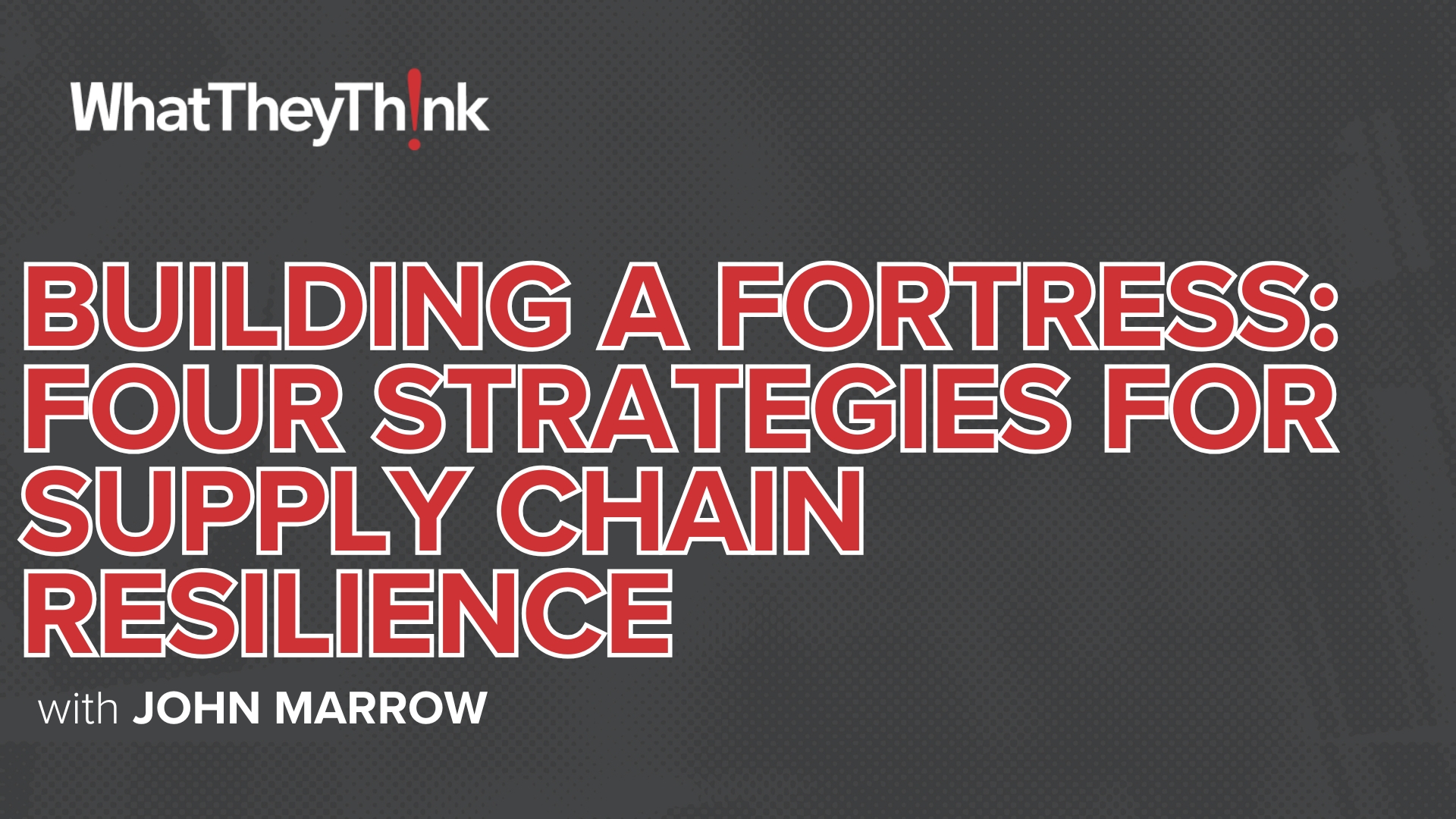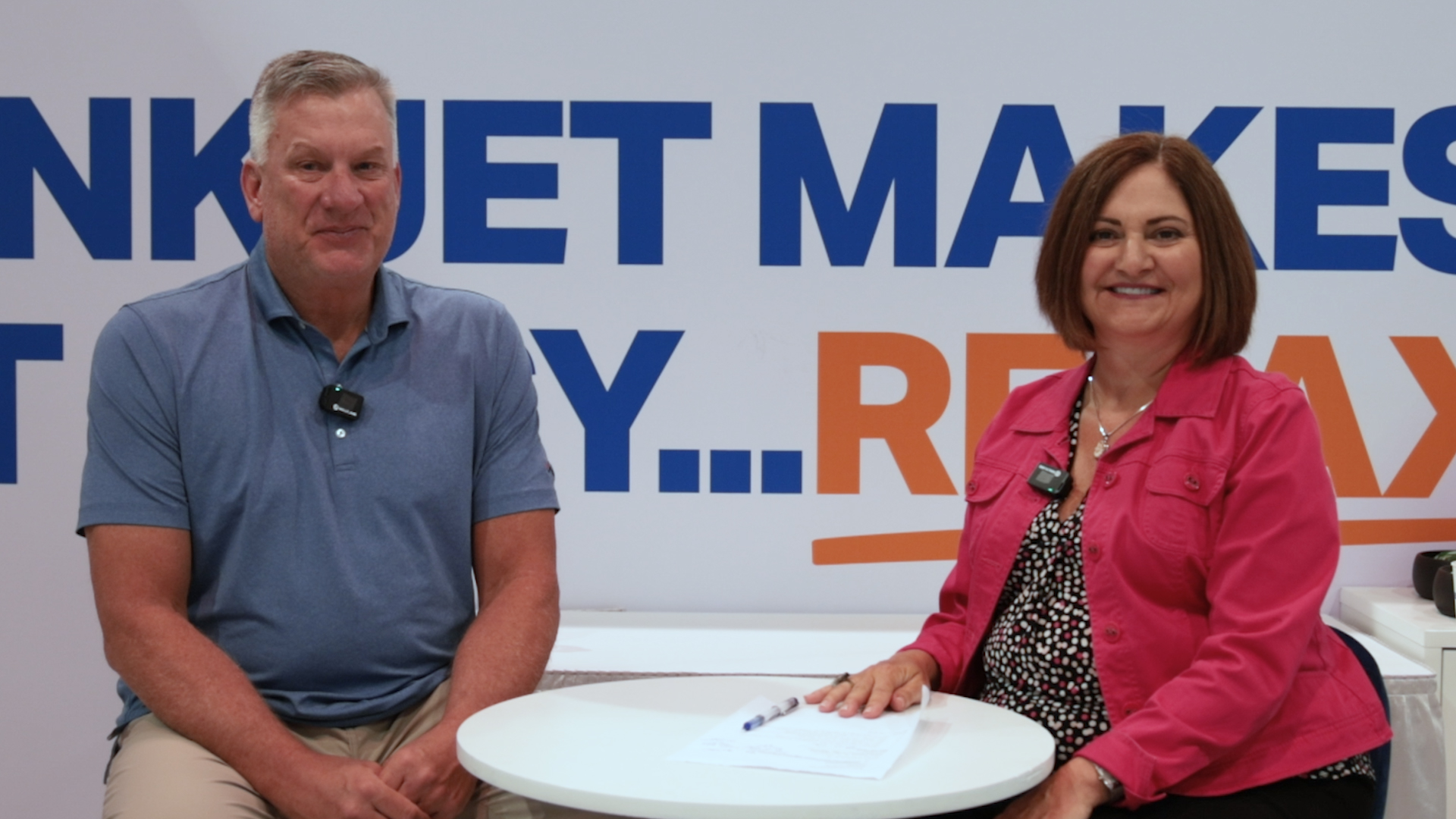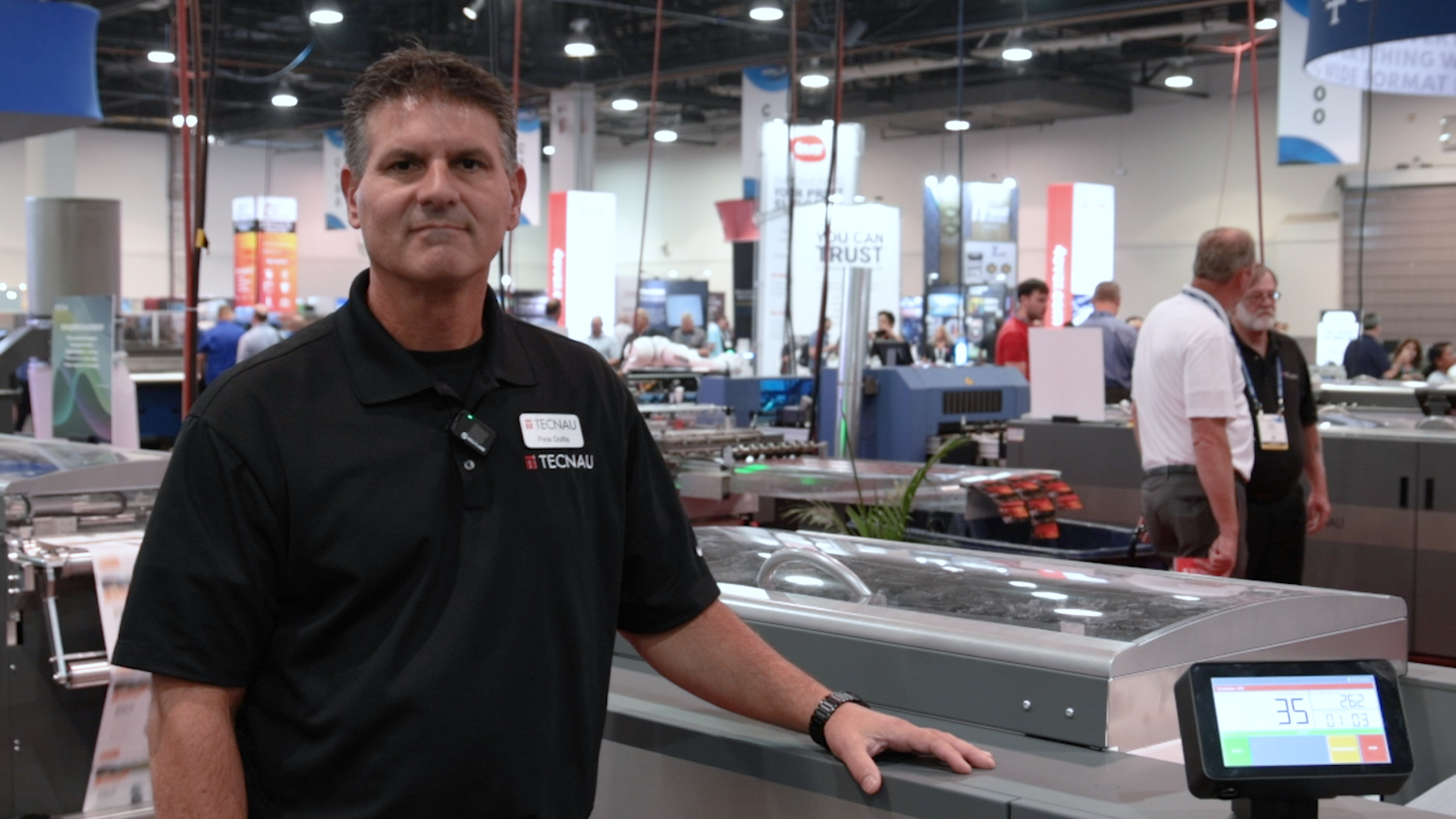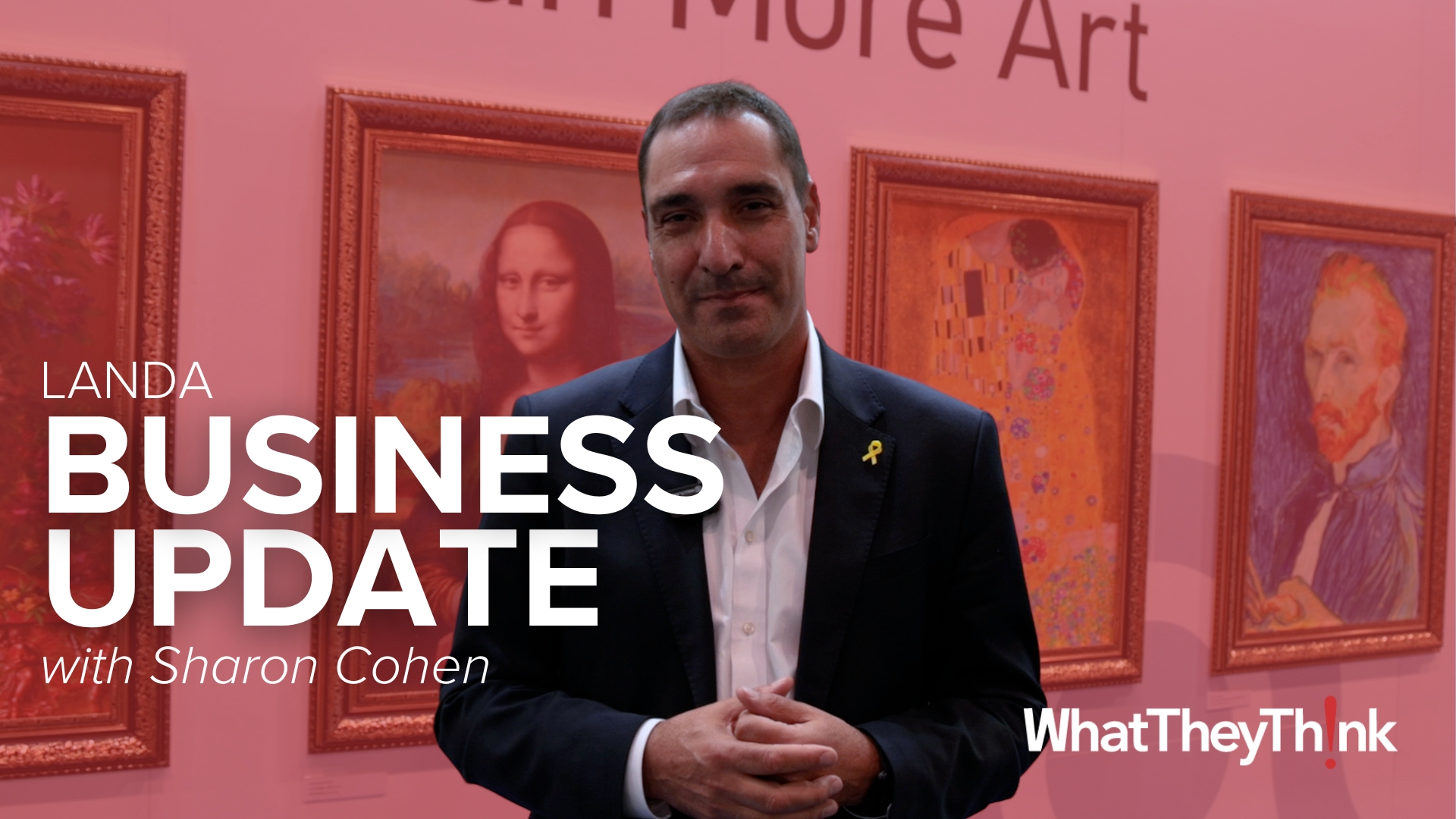Commentary & Analysis
Displaying 951-1050 of thousands of articles
Insight You Need. Analysis You Trust.
Get the trusted insights you need to understand our evolving industry and emerging trends. Become a Premium Member.
Around the Web: Font Finale. Wide-Format Whiskey. BBall Boon. Fold Fashion. AI Attorneys. Turntable Tech. Obsolete Objects. Disquieting Design. Disturbing Drones. Peep Pop.
Adobe has officially ended support for Type 1 fonts. Order a Jameson Whiskey “Desk Decoy” for St. Patrick’s Day. Wilson creates a 3D-printed basketball that doesn’t need inflating. Uyen Nguyen creates “origami fashion.” London law firm uses AI to answer questions about the law, draft documents, and draft messages to clients. Graphene is used to make turntables. Smithsonian magazine traces the origins of the term “OK.” Consumer items that have become obsolete since the beginning of the 2000s. Deliberately annoying examples of bad industrial design. The Smithsonian and MTV team up for an artist reality competition program, for some reason. Using taxidermied birds as drones. Pepsi and Peeps partner to make Peeps-flavored cola. All that and more in WhatTheyThink’s weekly miscellany.
DTG Printing Machinery SS/2023 Review: Stellar Growth and New Technologies to Explore
Stellar growth in the use of direct-to-garment (DTG) digital textile printing machinery continues to provide a unique and highly successful business model, gaining traction worldwide. As a technology built to deliver speed to market, it’s built for on-demand production and as such sustainable manufacturing—driving down inventory and production costs. In this article, provided by textiles expert and WhatTheyThink contributor Debbie McKeegan, you'll learn not only about DTG opportunities, but also the growing field of direct-to-film for garment printing.
Maximizing the Benefits of Personalized Communications
In the constant battle for consumer attention, marketing managers have a variety of communication options—digital and physical—for reaching their customers. Despite ongoing concerns about data security and privacy, consumers still expect a personalized experience from the firms that they do business with. This article explores how personalized communications can foster loyalty, increase customer engagement, and ultimately deliver the best possible experience.
Competence in Leadership
How to go about developing leaders is not well understood. Yes, there are certain types of knowledge that is needed and relatively easy to come by. There are important skills that help the accomplishment of a leader’s objectives and there are many sources to drawn from to learn them. The right type of experience can play an important role and it’s typically not hard to discern If a developing leader has that or not. Most people, however, are not aware of a number of behavioral competencies that, when mastered, are highly predictive of success in leadership. Wayne Lynn introduces the most important one in this article to illustrate the point.
Survey Results: What Happens When Traditional Paper Stock Is Not Available?
This prolonged period of paper shortage has required patience, persistence, and creativity from both printers and their customers. How is the industry responding? This article looks at the results of WhatTheyThink's survey on what happens when traditional paper stocks are not available.
Three Inkjet Workflow Pain Points and One Answer—Part 1: Labor as Friction, Automation As Lubricant
In this series we look at three of the top inkjet workflow pain points and paths to reducing the friction they cause with one technique that pays off. It starts with data but doesn’t end there. Data requires analysis and interpretation.
Xeikon Extending Its Label Line-Up
Digital label printing has been a growth market for many years, served by a large number of printer suppliers. Xeikon, offering both electrophotographic and inkjet label presses, expands both product lines. European section editor Ralf Schlözer looks at the new units.
Turkey, Textiles, and the Horrific Earthquake
The earthquake in Turkey was a truly devastating event. The death toll is nearing 50,000, a toll that is expected to grow significant over the coming days and weeks, making it the worst disaster in the country’s modern history. The only good news is that, miraculously, rescue teams are still pulling survivors from the rubble, including three that were rescued 11 days after the event, which occurred on February 6. The Istanbul Fashion Connection was scheduled for February 8 to 11 in Istanbul. Hanna Abdulla, News Editor for Just Style, was in the country for the event. We share a few of her insights about how the industry is working to help during this crisis and some background on the textiles industry in Turkey.
Assorted Publishing Establishments—2010–2020
According to County Business Patterns, in 2020 there were 557 establishments in NAICS 511199 (All Other Publishing). This category saw a net decrease of 39% since 2010, , although we’re not talking about a tremendous number of establishments. In macro news, inflation appears to have peaked.
Around the Web: Bing Bungling. Digital Decemberists. Design Deets. Blueprint Bop. Taxi Trial. Arm Addition. Milk Machine. Goat Gala. Air Ale.
Bing’s AI chatbot amuses and terrifies. Band frontman Colin Meloy has ChatGPT write a Decemberists song. Trends in experiential design. A metallic print that maps the history of jazz in the style of a circuit diagram of a 1950s phonograph. Graphene-based water purification. Stay off the sidewalks: robotaxis now approved for on-street use in California. Bill Watterson of Calvin & Hobbes fame has a new project coming out. Researchers are working on giving humans a robotic third arm that can be controlled by the brain. A countertop device for making vegan milk. A Valentine’s Day “goat fashion show” in San Francisco. A San Diego brewery uses the airport’s air conditioner condensation to make beer. All that and more in WhatTheyThink’s weekly miscellany.
Giving Cybersecurity the Attention it Deserves
As they strive to keep pace with today’s customer-centric marketing, many organizations are responsible for protecting a huge quantity of personal and confidential data. Consumers often view sharing their confidential data with businesses as a necessary evil—they want to receive personalized marketing pieces, but they are concerned that their information could be compromised. This article explores why it’s more important than ever to understand cybersecurity and protect consumer data.
Epson And Yuima Nakazato Spotlight New Technology and Circular Fashion at Paris Fashion Week
Japanese designer Yuima Nakazato chose Paris Fashion Week to launch his latest collection. He seeks to deliver garments that enhance the life of the wearer whilst seeking to improve the environmental impact of the fashion Industry and ultimately to democratize couture. His work symbolizes the reform of apparel—where design and materials combine to deliver a biophilic experience, nurturing the body and the planet simultaneously.
This Plant Wouldn’t Run Without Me
In conversations with a label converter recently, the General Manager told me that more than once in the last few years key employees had voiced the core belief that “this plant wouldn’t run without me.” Now, you can take this statement a lot of different ways. My initial reaction is concern for the business because the employee that says this is both likely a key player and potentially a risk.
Commercial Paper Remains Tight, But Things Are Improving for Labels
While paper shortages and associated inflation will continue into 2023, there is good news coming from the label world. While domestic energy, packaging, and freight are not declining, suppliers are starting to see them stabilize and the supply chain ease as a result.
Turnover and Employment in Print in Europe—UK
This bi-weekly series of short articles aims at shedding a spotlight on the size of the printing industry in Europe per country and how revenues and employment developed in 2020, when the pandemic impacted businesses. This time we look at the UK, the second-largest printing industry by turnover in Europe.
New Challenges and Approaches to Packaging Workflows—Part Three
The integration of analog and digital equipment can provide lots of opportunities but also challenges in plant optimization. Workflows, especially front office and plant for packaging operations, have to address many complexities not found in commercial printing workflows.
Can the Fashion Industry Accelerate Climate Action Fast Enough?
As fashion week hits New York’s runways it's a good time to review the state of the industry and its progress...or not...toward a more sustainable future. Here we provide high level results from a research report produced by The Climate Board in partnership with Textile Exchange: “Friction Points in Fashion and Textiles: Removing Barriers and Accelerating Climate Action.”
Women’s Networking Luncheon Kicks Off Annual Event at ePS CONNECT
This year’s CONNECT event, hosted by eProductivity Software at The Wynn in Las Vegas, featured a Women’s Networking Lunch where women—along with some men—gathered to hear the stories of powerful women and discuss ways to get more women into the industry and leadership positions.
Tales from the Database: Software
In our January/February 2023 print edition, we are launching a new series called “Tales from the Database,” drawing on six years’ worth of Print Business Outlook surveys. In every survey, we ask a broad cross-section of print businesses about business conditions, business challenges, new business opportunities, and planned investments. January/February is the software issue, so we rounded up a few software-related challenges, opportunities, and investments to see what the historical data can tell us.
Around the Web: Typing Tome. Typographic Talking. Dated Doodling. E Etiquette. Kayak Composite. Faux Phoning. Dodo De-Extincting. Fatal Philodendron. Carb Crazy.
A comprehensive book about keyboards. “Type empathy.” Researchers explore ancient book doodles. What are the new rules of etiquette, online and off? Graphene is used to make stronger and lighter kayaks. iPhones and “smart” watches are inundating 911 with mistaken emergencies. A company called Colossal Biosciences aims to bring back the dodo à la “Jurassic Park.” A machete-wielding plant. Move over, pastini: three new pasta shapes now available! All that and more in WhatTheyThink’s weekly non-balloon-centric miscellany.
COP Out: COP27 Left More Questions Than Answers
Senior Editor Cary Sherburne reports on the results—such as they were—from the United Nations Framework Convention on Climate Change’s most recent conference, COP27, held in November in Sharm El-Sheikh, Egypt.
Executive Q&A: Nick Benkovich, Vice President Of Product Management at eProductivity Software
WhatTheyThink talks to eProductivity Software’s Nick Benkovich about how print businesses’ software needs are changing in response to changing customer needs.
Going for the Gold: Pro Tips to Get the Most Out of Your Digital Embellishment Production
Taktiful’s Kevin Abergel talks to three experienced digital embellishment producers about how they get the best results from different papers, laminates, and foils and how they feed that knowledge back to their customers.
Keep the Napkin: What Started as a Small Idea Turned into a Multimillion-Dollar Company
Software is the future of every printing business. At More Vang, it’s the present. More Vang president Jon Budington explains how More Vang went from commercial printer to software developer.
Taking the Lead: Textiles Thought Leaders Are Lighting the Way to a More Sustainable Industry
The textiles and apparel industry overall has seemingly made little progress toward stated sustainability goals, but there are bright spots that light the way to a more sustainable future for the industry. In researching this article, we spoke with three thought leaders in the industry who we hope will act as an inspiration to others, accelerating the industry transformation that must ultimately occur, including Adobe, Raspberry Creek Fabrics and Spoonflower.
The Target Report: The Box is Back—January 2023 M&A Activity
Italy-Based Pusterla Acquires Two US Box Makers, Supremex Executes Box Strategy; and more…
Making the Connection: Software Connects the Dots for a Display Graphics Provider
What do we talk about when we talk about “software” in the context of display graphics production? When it comes to print production, and especially “workflow automation,” what we’re usually talking about is “RIP and print” software—and getting this software to talk to all the other software in the shop.
Working Over Your Workflow: 5 Steps to Turn Your Digital Printing Workflow into a Profit Maximizer
Reviewing your workflow on a regular cadence can lead to continuous improvement. It can also lead to continuous savings! With every new software tool and every new device there will be opportunities for more efficiency and optimization. Here is how to build your profit maximizer.
Small Business’ Growing Investment in DIY Marketing Software Creates Opportunities for Savvy Printers
Increasing numbers of small and mid-sized businesses are investing in DIY marketing automation. Platforms such as MailChimp, Pardot, and HubSpot lower the barrier to entry, but without the marketing and database expertise to put them to use, those tools are little more than window dressing. Heidi Tolliver-Walker explains how understanding where and how to plug in can be of significant value to those customers.
Off-the-Shelf Software Is No Solution: How to Customize a Software Solution That Solves Your Workflow Needs
With the shifting market directions of procurement and print production there is a lot to be learned about the new requirements, processes, and pain points of the customer base. Building a “one size fits all” solution will usually fall short of those goals. Ultimately the solution needs to fit the specific needs of a PSP and their customer and partner relationships.
Stop Buying Sticky Notes: Print Software Providers Are Developing Software to Evolve with Your Company
Senior Editor Cary Sherburne looks at how print software solution providers are responding to the evolving needs of customers.
Graphic Arts Employment Flat or Declining in December
Overall printing employment was essentially flat in December 2022, being down -0.1% from November, and essentially unchanged from December 2021. Production employment was up +0.4% while non-production employment was down -1.1% from November.
Around the Web: Type Tropes. Found Font. Box Boom. Synthetic Sermon. Moon Minutes. Time Trouble. Sinkhole Signage. Dip Dissed. Fowl Felon.
Monotype released its 2023 Type Trends Report. The mystery of Frank Herbert’s “Dune” typography revealed. The growth in demand for…newspaper boxes? A rabbi delivers a sermon written by ChatGPT. A visual game in which you are shown a photograph and have to identify what year it’s from. What time is it on the Moon? Rolex is suing a maker of children’s clocks. You might want to pay attention to “Road Closed” signs. Trader Joe’s announces its (controversial) Customer Choice Awards. A former Chicago area school district official allegedly stole more than $1 million worth of chicken wings. All that and more in WhatTheyThink’s weekly miscellany.
Green Printing to Drive Future Innovation in Equipment and Inks, Says Smithers
Sustainability in printing is an increasing priority across the world, with print buyers paying more attention to the carbon impact of all their business activities. This can provide a demonstrable commercial advantage for those print systems and operations that give a genuine reduction in environmental impact. In this article, Smithers shares its latest insights into the short- and medium-term impact of the drive to greener printing.
Printing Outlook 2023—Back In Black
Digging into the results of our Fall 2022 Business Outlook Survey for the our annual Printing Outlook 2023 report, they showed an industry that is indeed “back in the black.” However, new challenges other than the pandemic plagued print businesses in 2022, and while many of them are easing as we head into 2023, new challenges are on the horizon.
The Competent Business
It has never been harder to survive and thrive in the graphics industry. Increasingly, the bar is rising on what is required of owners, CEOs, and employees. Are you thinking about how to improve the overall competence of yourself and your people?
The Labor Challenge of Print Software Expertise
Printers are complaining of the lack of qualified candidates and a higher-than-expected amount of turnover. While this section of WhatTheyThink is titled Software, the focus is often more on people than software. After all, people are what make your software investments' ROI. Software is simply potential.
What Are You Telling Your Customers About the Paper Shortage?
The height of the pandemic is behind us. The supply chain is moving again. Why are paper prices still so high and paper still in short supply? How do you explain it to your customers?
Who Manages Print Industry Standards?
We are starting the year with standards to embrace a year of optimization, automation, and growth. The focus this time is on the groups that help us manage the standards. These are the groups to watch because they are managing the processes that lead to changes in existing standards as well as new standards.
New Challenges and Approaches to Packaging Workflows—Part Two
More printing companies are finding opportunities in packaging production as more targeted and shorter packaging production runs increase and new digital tools help reduce the skill sets required. However, many are finding that different production tools and workflows as well as new processes are required to optimize and succeed.
Nearshoring, Reshoring, Onshoring and New Shoring: The Face of Made in America Is Changing
The U.S., for several years, has been trying to bring back manufacturing across the board, including textiles and apparel. The pandemic and the resulting supply chain crisis spurred more action toward this goal. But simply bringing back manufacturing and doing the same old things, only here in America, I don’t believe plays into the American ingenuity theme. That’s where new shoring comes in. Yes, bring back manufacturing. But do it in a way that is innovative, automated, sustainable, and yet competitive. For more details about new shoring, there is an excellent article available on “The Sourcing Journal” (subscription may be required).
Around the Web: Map Mania. Wrapped Ride. Bot Bill. Nullifying Knitwear. Calamity Clock. Core Conundrum. Scent Sensors. Wall Wings. Phishing Fish. Soda Sauce.
Sales of paper maps are soaring. Snoop Dogg’s adventures in vehicle wrapping. Massachusetts legislators use ChatGPT to write a bill…regulating ChatGPT. Wearing an ugly sweater can make you invisible to AI, if no one else. Scientists change the Doomsday Clock to 90 seconds to midnight. If it’s not one thing it’s another: now the Earth’s core has stopped spinning. Graphene-based sensors function like “electronic noses.” A Reddit embroidery forum 2022 award goes to embroidered chicken wing wall art. A bunch of aquarium fish pull off a credit card scam (not The Onion). Mountain Dew releases a hot sauce. All that and more in WhatTheyThink’s weekly miscellany.
Greeting Card Publishing Establishments—2010–2020
According to County Business Patterns, in 2020 there were 107 establishments in NAICS 511191 (Greeting Card Publishing). Although this represents a net increase of 4% since 2010, it has been a category that has ebbed and flowed over the course of the decade, although we’re not talking about a tremendous number of establishments. In macro news, real GDP increased 2.9% annualized in Q4.
The Lasting Appeal of Physical Mail
Today’s customers have more options than ever when deciding how to interact with their transactional communications (i.e., bills and statements). Printed mail is no longer the only way to receive bills and statements, but many consumers still recognize and appreciate print’s value. This article cites recent research to highlight the importance of physical mail.
Texintel Live Interview with EFI Reggiani’s Adele Genoni
This video interview, conducted by and provided compliments of textiles expert and WhatTheyThink contributor Debbie McKeegan, discusses digital textile printing with Adele Genoni, senior vice president and general manager of EFI Reggiani. They discuss new printing technologies and Adele shares her insights on industry trends and how EFI Reggiani technology is evolving to fulfil market demands.
Where Are Marketing Budgets Increasing and Decreasing in 2023?
Where are marketers’ budgets increasing and decreasing in 2023? Two studies, R. R. Donnelley’s “Optichannel Opportunity Report” and Neil Patel’s “How Marketers Are Spending Their Money” paint a consistent picture. The money is going where the proof of ROI is.
Legendary Game-Saver Becomes a Game-Changer for Print Industry Recruitment
Expert training, hands-on experience, professional certification, and supportive mentoring: all of these advantages await the young people taking part in a unique partnership for workforce development between the printing industry and a leading charitable institution.
New Challenges and Approaches to Packaging Workflows—Part One
Since there is an increasing shift of consumers from large global brands to smaller local/regional brands, so is the amount of disparate packaging required. However, while the diversity of needs commercial print are feeling the pressures, packaging adds many other level of complexities.
Turnover and Employment in Print in Europe—France
This bi-weekly series of short articles aims at shedding a spotlight on the size of the printing industry in Europe per country and how revenues and employment developed in 2020, when the pandemic impacted the businesses. This time we look at France, the fourth-largest printing industry by turnover in Europe.
Regenerative Fashion: An Exit Strategy for Fashion’s Troubled Relationship with the Planet?
There is no denying the negative impact the multi-trillion-dollar global fashion industry has had—and continues to have—on the planet. Some fashion brands are making honest and open efforts to reduce their carbon footprints; some are greenwashing; and some are simply doing nothing. Until consumers take a stand and drive Fast Fashion out of their wardrobes, not much is likely to change. But there is hope on the horizon, according to Paul Foulkes-Arellano of Circuthon Consulting. In this article, learn about Regenerative Fashion, benefit from Foulkes-Arellano’s deep insight, and think about how you can change your buying habits to help reduce fashion’s impact on the planet.
November 2022 Shipments Drop—But That’s Normal!
November 2022 shipments came in at $7.16 billion, down from the year’s high of $7.48 billion in October. This should not be cause for concern, as business always drops in November and December as things slow down for the holidays.
Around the Web: Pilfering Probe. Font Feud. Retailer Renaissance. Obsolete Offices. Flame Fighting. Credit Credibility. Cool Container. Romantic Russets.
Here we go: there is now a “plagiarism checker and AI detector.” The State Department changes its internal document font and war breaks out. Barnes & Noble has had a remarkable comeback—how? A Colorado library closes to clean up meth contamination. Zillow CEO writes that “traditional offices are as outdated as typewriters.” Graphene-enhanced gear can help protect firefighters. Celebrate Burns Night next Wednesday. FEMA attempts to translate typhoon aid instructions into indigenous languages—with surreal results. A new startup aims to make carbon credits credible. A new fridge container has a built-in dial to indicate when it was stored. This Valentine’s Day, send your beloved an “Idaho potato bouquet.” All that and more in WhatTheyThink’s non-AI-generated weekly miscellany.
Back In Black: Wide Format 2023—Six Things to Pay Attention to
Here we are in 2023, and one theme in our Fall 2022 Business Outlook Survey was that, for those print businesses that languished during COVID and its immediate aftermath, 2022 was the year they got back in the black. Still, 2022 was a challenging year in many ways. Not as challenging as 2020, thankfully, but still not an easy year to navigate, and there is no doubt that 2023 will present its own challenges—and opportunities. Here are some things to keep an eye on.
Aquario Textile Designer Delivers Essential Tools for Surface Pattern Design—Create, Color, Repeat, and Print
Have you been wondering whatever happened to Adobe Textile Designer? In this article, compliments of textiles expert and WhatTheyThink contributor Debbie McKeegan, we learn what Aquarios, who is now licensing and further developing Adobe Textile Designer, has up their sleeves. It is also important to note that the software supports a PDF workflow, which can be more efficient than a workflow dependent on image files.
Using Eye Tracking to Determine Shopper Interest
Have you ever wondered how the big CPGs determine which packaging designs work and which don’t? For many, it’s as much science as it is creative. To get insight into just how much science can go into it, take a peek at Quad Graphics’ Package Insight division.
Buying a Print MIS/ERP is an Event, ROI is a Journey
A Print MIS/ERP purchase is an event; the journey is where actual differentiation takes place.
Three Reasons to Adopt Standards
This year, we are going to explore a wide range of trends, thought-provoking ideas, concerns, and the role of hardware, software, workflow, automation, and standards in how we communicate to clients, customers, and constituents. That is a mouthful. It’s ambitious. But it would be a fascinating ride. The starting point is the role of standards—something our industry tends to honor in words, but not deeds. =
Bring Agility to Your Print Business with First Line Software
It can be challenging for print businesses to be agile, particularly production printing rooted in small-batch, custom manufacturing. To reach the peak of business agility, you may need to be agile using software and software services. Pat McGrew and Ryan McAbee look at how First Line Software’s custom software and data solutions can help improve print business agility.
Hunkeler Innovationdays: A Unique and Important Event
Hunkeler Innovationdays is not really an expo as you might expect, but is instead a unique gathering and presentation of complete digital print and finishing workflows. There are no expos or other events like this that provide the latest in digital printing and finishing equipment, in live and running complete multi-vendor end to end workflows.
A Deep Dive into Climate Action—or Inaction
The venture-funded Climate Board, established in 2022, has amassed a wealth of materials on the topic of sustainability, including insights and research, and has conducted a variety of events. It was founded on the belief that knowledge-sharing is crucial to accelerating climate action. Its work attempts to bring solutions, supported by experience and evidence, to drive speed and progress. But there is a huge mountain to climb. A key finding of its research is that for many organizations, “Ambitious goals are more than twice as common as meaningful action.” This is not where we want to be. In this article, we explore some of the challenges and opportunities for mitigating climate change.
AI-Generated Images Will Spark a Revolution
European section editor Ralf Schlözer takes a close look at AI-generated images, experimenting with some of the tools currently available, and exploring what the implications of AI imagery are for the graphic communications industry.
Around the Web: Computer Creatives. Sign Stickers. Dystopian Devices. Carbon Cousin. Loco Logo. Rodent Research. Webb World. Butter Battle. Pasta Problem.
How worried should creative professionals be about artificial intelligence? A Florence, Italy, street artist who applies whimsical stickers to traffic signs. CNet looks at some dubious introductions at last week’s CES. The FTC has proposed banning companies from requiring that employees sign noncompete agreements. Researchers have found a “cousin” to graphene, which they have dubbed “graphullerene.” Kia’s new logo is illegible. New Wordle-esque game lets you guess the list prices of houses for sale. Good news for mice this week—researchers are prolonging their lives and improving their memories. The James Webb Space Telescope finds its first exoplanet. A fire in a Wisconsin daily causes melted butter to flood nearby streams. Ronzoni discontinues its Pastina and the Internet sees stars. All that and more in WhatTheyThink’s weekly miscellany.
Other Publishing Establishments—2010–2020
According to County Business Patterns, in 2020 there were 664 establishments in NAICS 51119 (Other Publishing). This represents a decrease of 35% since 2010. In macro news, what’s behind the employee shortages?
New Developments at the High End of Production Digital Print
Production inkjet has been seeing great growth, especially after the enhancements in print quality, but electrophotography continues to have some advantages—particularly for higher ink coverage commercial applications. This article considers some new high-end production digital print technologies that will compete for market share and print volume in the future.
Winning in 2023 Is a Team Effort
We present a virtual roundtable of Dscoop and HP Industrial Executives. They discuss the upcoming event in St. Louis, the value of the global Dscoop community, and the close connection between HP and its users as they transform the digital print industry in 2023 and beyond.
Textiles From Seaweed Moves a Step Closer as AlgiKnit Raises $13 Million in Series A Funding
One of the challenges for textiles and apparel with regard to its abysmal sustainability performance is weaning itself away from petro-based fibers, including polyester and polyester blends, which account for about 60% of garment fabrics today. We've written about a number of alternative natural fibers that could replace these detrimental fossil-based plastics. Most recently, seaweed has surfaced as a potentially viable alternative. Sound icky? It’s not. Be sure to read this article compliments of textiles expert and WhatTheyThink contributor Debbie McKeegan that describes the potential of AlgiKnit yarns to make a difference in sustainability for textiles and apparel.
Case Study: Using Google Analytics to Dig Below the Surface
For their New Year’s marketing resolutions, many companies are committing to making better use of Google Analytics to track their traffic and evaluate their marketing efforts. Google Analytics can be a powerful tool, but if you don’t dig deep, it can be misleading, too.
Turnover and Employment in Print in Europe—Italy
This bi-weekly series of short articles aims at shedding a spotlight on the size of the printing industry in Europe per country and how revenues and employment developed in 2020, when the pandemic hit the market. This time we look at Italy, the third-largest printing industry by turnover in Europe.
Corrugated Goes Hybrid
The demand for shorter runs is increasing, driven by consumer market shifts across the packaging landscape. However, justifying the cost of digital corrugated production per package/box, when the ink cost is almost 10X the cost of flexo ink, and close to equal with the media in some cases, is difficult unless there is some added value or a more efficient solution.
Flagship Press Achieves Efficiency and Sustainability with KODAK PRINERGY, COLORFLOW Pro, and INSITE Horsepower
Flagship Press prints everything from books to direct mail, large format to promotional products, because they embrace their range of offset and digital equipment. But their workflow was slow, hard to maintain, and needed more of the features their volumes demanded. They started the search for a faster more automated workflow. In this case study, written and sponsored by Kodak, the answer was Kodak.
The Key to Z: Managing to a Generational Shift
Last summer, we asked our readers, “Are you ready for the Gen Z work force?” As we enter 2023 and the balance between open jobs and available employees still has not balanced out, it’s time to revisit this topic again. Remember that Gen Zers will make up 25% of the workforce by 2025, when they will range in age from 13 to 28. They are a rich source of potential employees—now and for years to come. We thought it would be good to review what they are looking for, how to hire and retain them, as we enter 2023 with an economy this is still a bit chaotic.
The Target Report: Private Equity Feeds Industry Growth—December 2022 M&A Activity
Fortis Completes Banner Year, Commercial Printing is Back; and more…
Graphic Arts Employment Essentially Flat in November
In November 2022, all printing employment was up +0.1% from October. Production employment was up +0.7% and non-production employment was down -1.2%.
Around the Web: Marketing Muster. Creating Crayons. Joe’s Journalism. Going Graphene. Feather Photography. Car Colors. Checking Chuckling. Fish Fiasco.
Marketing Brew rounds up the most overhyped and overlooked marketing trends of 2022. A new book looks at the history of the crayon. Our own Dr. Joe presents a four-part radio documentary about newspapers in old radio dramas. Graphene is poised to replace silicon as the basis or all electronics. Smart elevators look to take us for a ride. Facial recognition for birds via a “smart feeder.” BMW’s E Ink-wrapped car can display millions of colors for quite the road show. Printed electronics for therapeutic wearables. The cool upgrade on Brava’s smart countertop oven is a…glass window. The “LOL Verifier” is a device that will only let a user type LOL when they are actually laughing out loud. A huge aquarium in a Berlin hotel bursts. All that and more in WhatTheyThink’s weekly miscellany.
Survey Says! Signage and Display Graphics in 2023
It’s that time again, time to sift through the data from our annual Business Outlook Survey for the forthcoming Printing Outlook report. As has become an annual tradition, we break out some wide-format specific data to see what trends we can quantitatively gauge.
Meet Fashion Designer Megan Van Engelen, Winner of the Epson Design Awards
Events like Epson Design Awards are critical to helping new talent get recognized and established. It is this new talent that is the hope for our future. This year, the recipient was Megan van Engelen. In accepting the award, she said, “I really want to tell my story, and I think that’s more important than saying that the world is dying, because at this point, we need to show people how we can offer solutions and I think that’s what designers are for, and that we show people how we can be more sustainable.” Thanks to textiles expert and WhatTheyThink contributor Debbie McKeegan for sharing this story.
Seven Marketing Shifts for 2023
HubSpot’s Inbound Marketing Report 2023 takes a look at the changes expected for marketers in the coming year. Specifically, there are seven fundamental shifts HubSpot sees occurring among marketers (and impacting everyone else) in 2023. What are they?
Standardized vs. Tailored Implementation Services
Optimization efforts can often result in generalized approaches that miss the mark of delivering what each customer needs, when they need it, based on their specific business needs.
For Gallus, New Leader Brings New Approach to the Future
Today, Gallus and Heidelberg, after some difficulties in the past, are affirming their roles as “natural relatives” to create the innovation and solution which benefit their customers and the industry as a whole.
Help Your Sales: Update Your Website
You know what they say about cobbler’s children? They never have good shoes because the shoes go to paying customers. We have the same challenge in the print industry. Even companies that offer website design as part of their services offering struggle to create a compelling website for their own services. Let’s talk about that!
Johnson’s World—Christmas Times A-Comin’
Steve Johnson shares some tips for sending Christmas cards.
A Printing Carol
Frank has a visit from the Ghost of Printing Past.
Giving: What Goes Around Comes Around
As things start to wind down for a little while, many of us step back, think about new year’s resolutions, and take a look at what we do, how we got here, and where can we go in the future. Those reflections, in some cases, also remind us that perhaps life is really about the rewards of giving.
Around the Web: Clumsy Cat. Welding Wishes. Beautiful Books. Book Binge. Wednesday Website. Color Can Conundrum. TENG Tech. Fusion Feat. PEARLS Peering. Sculpture Saviors. Cheese Cheer. Large Loop.
The winners of the Comedy Wildlife Photography Awards. This Christmas, give the gift of welding classes. How to gift wrap a dog. “The 60 Most Beautiful Books of 2022.” An exhibition called “Building the Book from the Ancient World to the Present Day.” Find out if it’s Wednesday. Seeing red in an image that has no red pixels. Artist and activist Stuart Semple rebels against the color of the year. Graphene-enhanced power sources for flexible electronic devices. What the “fusion experiment” at the National Ignition Facility actually accomplished. Police break into an art gallery to rescue what turned out to be a statue. Dictionary.com weighs in with its word of the year. Adorn your home with the “Cheese Wreath.” Supersize your breakfast with the Big Fruit Loop. All that and more in WhatTheyThink’s pre-holiday miscellany.
Have a Little Holiday Cheer/October Shipments the Highest All Year
October 2022 shipments came in at $7.48 billion, up from September’s $7.32 billion—the best month of the year for the industry.
You Have Digital Embellishment—Now, How Do You Market It?
Taktiful’s Kevin Abergel talks to four print service providers about how they market their digital embellishment services and what levels of customer awareness they’re finding.
Dive Right In: Interactive Print Is Mainstream
If there is a story in interactive print these days, it’s accessibility, both for service providers and for their customers. The range of applications is staggering, from 3D product visualizations and virtual try-ons to AR filters, virtual brand ambassadors and 360 tours. Heidi Tolliver-Walker walks through the various platforms and applications.
Streamlining and Speed Are Key for Finishing: Emerging Trends and Technologies
Trish Witkowski rounds up the top trends in finishing and identifies new product introductions that are addressing those trends.
Association Insights: Foil & Specialty Effects Association and the Digital Embellishments Alliance
Foil & Specialty Effects Association (FSEA) executive director Jeff Peterson talks about FSEA’s new Digital Embellishment Alliance (DEA), created as an education and communication initiative for the growing digital embellishment segment of the printing industry.
A Carnival of Innovation: The Latest Textile Technology from PRINTING United
Textiles expert and WhatTheyThink contributor rounds up the textile and apparel technologies that were introduced and shown at PRINTING United.
Improving Results with a Well-Constructed Sales Guide
The process of selling is only becoming more complex with time. Developing and acquiring new business has become a chaotic labyrinth of tracking down prospects, nurturing clients, and closing the sale. Sales leaders must offer tools that create sales efficiency and eliminate the practice of experimenting on valuable clients and prospects. One way to do this is by developing a sales playbook.
Why the Time Is Right to Set Your Designs on Wallpaper
We’re hearing more and more about demand for customized wallpaper—or at least there are more providers offering this solution, ranging from family-owned Raspberry Creek Fabrics to Shutterfly-owned Spoonflower. In this article, compliments of textiles expert and WhatTheyThink contributor Debbie McKeegan, Phil McMullin of Epson talks more about the trend.
Time to Thrive: Digital Labels and Packaging Will Continue to Grow
David Zwang recaps the year in labels and packaging, with a look at notable product releases, and the continued growth of digital labels and packaging.
For Textiles and Apparel, Sustainability Is Key but Progress Is Slow
This was a year of recovery for textiles and apparel as supply chain issues began to settle a bit, and suppliers were back online after the pandemic. Consumers were also buying—both online and back in-stores, which is good news for brands. Senior Editor Cary Sherburne looks back at how the industry has slowly started to embrace sustainability and some of the initiatives to keep an eye on in 2023.
A PSP’s Guide to Choosing Marketing Technology
WhatTheyThink contributor Joanne Gore explains how to navigate the ever-expanding MarTech landscape.
Focus on Everything But Printing: Your Manufacturing Workflow Is the Ticket
Putting ink or toner on a vast range of substrates is something PSPs do daily, and the process is getting a bit easier every year. What is not getting any easier are the operational processes required before and after printing. Pat McGrew and Ryan McAbee explain how job onboarding, proofing and approval, and invoicing are the three most consistent problem areas found during workflow assessments for every type of print service provider.
Sales Clinic: Is Your Sales Playbook Holding You Back?
The world of professional sales has changed dramatically, and if you haven’t reviewed and revised your “Sales Playbook” in the past couple of years, it may be holding you back. Contributor Lisa Magnuson looks at a few critical changes affecting each sales stage.
Multiple Best of Breed Software Systems
More software systems create more complexity, which creates more overhead in your business. Choose wisely based on the realistic and mandatory feature sets required to run your business.
Uncovering the Consumer Mindset for 2023
What will consumers be thinking in 2023? How will they behave and what will drive their decisions? Answering these questions was the goal of GWI, an audience targeting company, in its U.S. “Connecting the Dots” report.
Offset Litho Is Far from Dead: Realism Goes Hand-in-Hand with Optimism as Sheetfed Offset OEMs Survey the State of their Marketplace
Offset lithography was the predominant printing process of the 20th century, and it has given up only limited ground to alternative printing methods in the 21st. Patrick Henry reports on how manufacturers of offset press equipment still see it as an essential product to deliver and a vibrant business to be in.
- Questions to ask about inkjet for corrugated packaging
- Can Chinese OEMs challenge Western manufacturers?
- The #1 Question When Selling Inkjet
- Integrator perspective on Konica Minolta printheads
- Surfing the Waves of Inkjet
- Kyocera Nixka talks inkjet integration trends
- B2B Customer Tours
- Keeping Inkjet Tickled Pink
© 2024 WhatTheyThink. All Rights Reserved.














